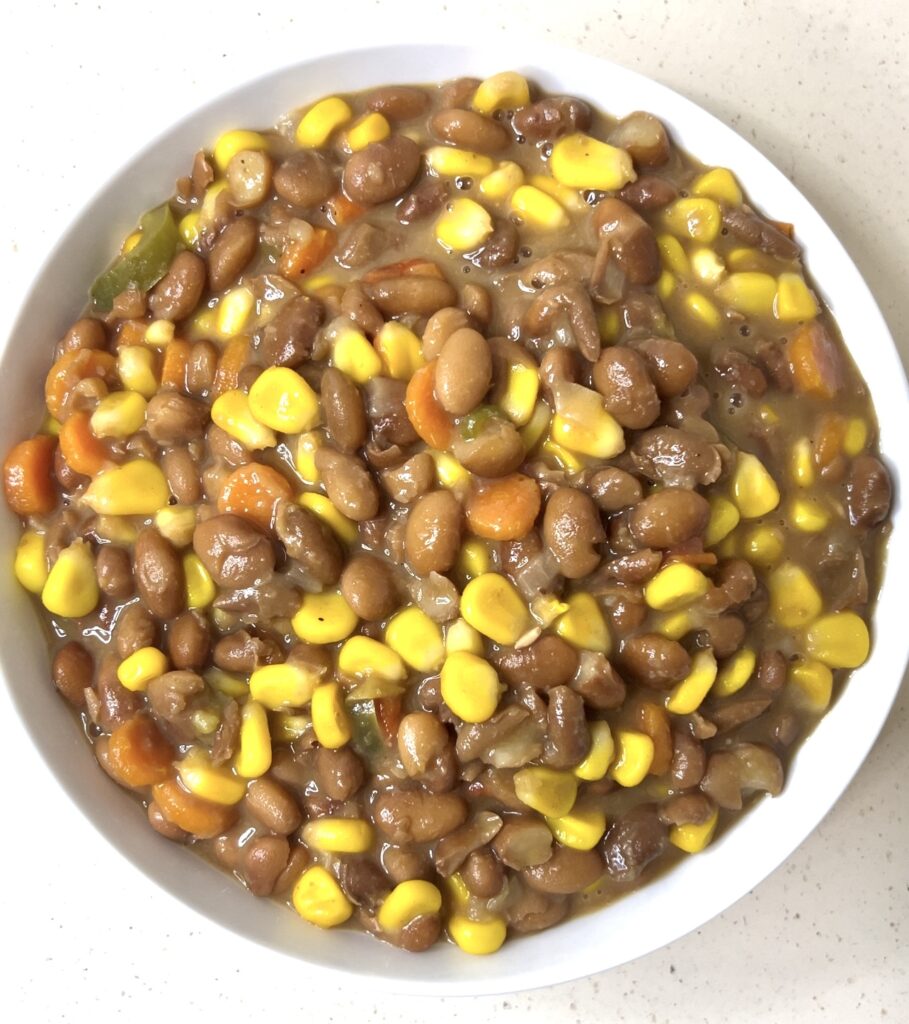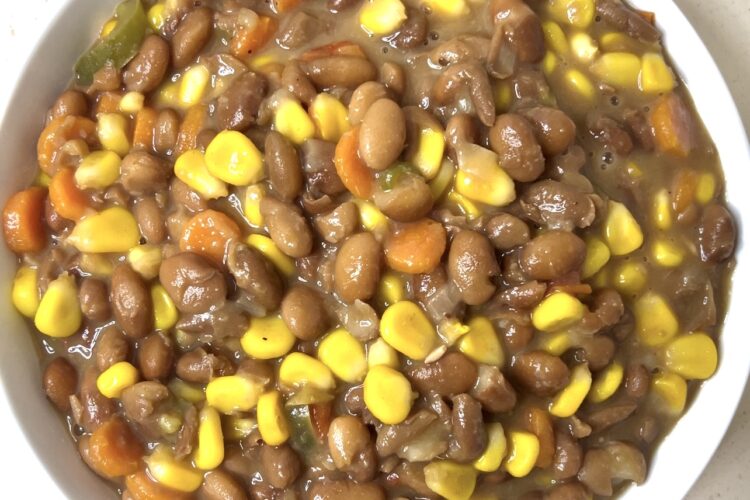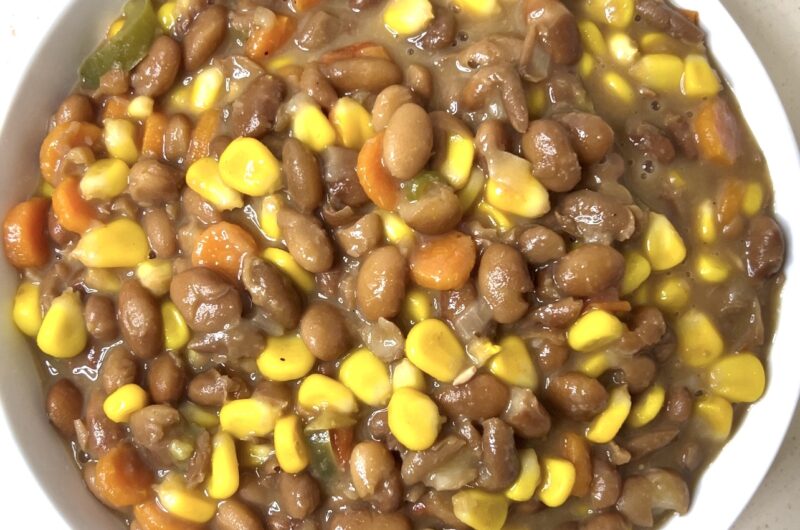This post may contain affiliate links, which means I may receive a commission from purchases made through the links.
Githeri is a beloved Kenyan classic made from boiled maize (corn) and beans. The dish is often enhanced with spices and vegetables to create a tasty and filling meal that keeps you full for so long. It is often served for lunch or dinner, but some will also enjoy it for breakfast with a cup of milk tea. Githeri is a simple, affordable, yet nutrient-rich vegetarian dish, hence why it is popular across the country, especially in Kenyan institutions. The dish is a staple in Kenyan public school diets, so much so that some Kenyans, including myself, sometimes dislike it (to put it kindly) because it reminds us of those days. I mean, when you are fed githeri five or six days a week, from primary school through high school, you kind of feel like you’ve had enough of it. Luckily, the dish is very customizable, and you can find ways to enjoy it with new flavors every time (not that that was the case in our school days, no). In this blog post, I am sharing with you the classic Kenyan githeri recipe, and we will explore all the variations to the dish and possible ways to make it new every time.
A Brief History of Githeri
Kenya is a country rich in culture, history, and, of course, food, and githeri is one of those dishes that is deeply tied to Kenya’s history. Records show that maize was introduced to Kenya by Portuguese traders between the 17th and 19th centuries. Although it was first introduced in the coastal region, it quickly spread inland. Later, the British colonialists promoted maize cultivation to export it to Europe as well as to feed the African laborers who worked on the settler farms. Most of those settler farms were located in the highly fertile Kenyan highlands, whose native inhabitants were largely the Agikuyu (Kikuyu) people. It is for this reason that Githeri originated in the Kikuyu community.
Perhaps the Kikuyu people who labored on the colonial farms experimented with maize and beans and found out that the dish was not only nutritious but also highly filling and energizing. They held on to the recipe, and over time, it spread across the country and beyond. Traditionally, githeri was a simple dish made by boiling maize and beans together with no crazy additions. Today, it has evolved with different variations, incorporating ingredients like potatoes, cabbage, carrots, even meat, and spices to give it more flavor and texture.

Nutritional Benefits of Githeri
- Protein-rich: The beans in githeri are rich in protein, making it an excellent choice for vegetarians and anyone looking to consume more plant protein. The best part is that these plant proteins are clean, affordable, and readily available to many.
- Energizing: Maize provides a good dose of carbohydrates to keep you fueled throughout the day.
- Rich in fiber: The high fiber content in githeri helps with digestion and keeps you feeling full longer.
- Loaded with vitamins: Adding vegetables like kale, cabbage, carrots, bell peppers, etc., enhances its vitamin and mineral content, giving your body a lot of great nutrition.
Typical Ingredients for Kenyan Githeri
- Dried maize (corn kernels): This is the traditional ingredient used to make githeri. However, many Kenyans also use (mature) green maize, the kind that is roasted on the roadsides as a popular street food – mahindi choma – to make githeri. For those of us living away from home, especially in the United States, both dried and mature green maize are hard to come by. We, therefore, must resort to the soft, sweet corn that is available here whenever we crave githeri. This option yields a softer githeri texture that is much different from the traditional type.
- Dried beans: Different types of beans can be used to make githeri. The most common ones are the red kidney beans and a variety known as Rosecoco beans, which are closely similar to pinto beans in the U.S. The goal is usually to use beans whose color contrasts with that of maize so that the dish can look more appealing. White bean varieties, therefore, are not a great option for this reason.
- Fresh Vegetables: The most commonly used vegetables are onions, carrots, bell peppers, Irish potatoes, and sometimes, tomatoes. Leafy vegetables like cabbage and kale can also be included in the dish. It all depends on your dietary preferences and what’s available to you. As I mentioned earlier, modern githeri recipes are endlessly customizable. Some people will add beef to the dish as well, but that is a recipe for another day.
- Seasonings: Githeri can be lightly seasoned with just salt, or you can choose to all in by using a variety of seasonings. Kenyans like to add seasonings like Royco mchuzi mix, githeri masala, or curry powder (Commissions Earned) to enhance the flavor of the githeri.
- Coconut milk: This is an optional ingredient, often more popular in Kenya’s coastal region, where coconut abounds. It adds a nice creaminess to the dish alongside that nutty flavor. In Kenya’s coast, maharagwe ya nazi (beans in coconut sauce), pojo (green grams in coconut sauce), and mbaazi ya nazi (pigeon peas in coconut sauce) are among the dishes that also popularly use coconut milk.

How to Measure Githeri Ingredients
Most Kenyans prefer githeri that has more beans than maize. I guess that’s because beans are more pleasant to chew on compared to maize, especially if the maize was originally dried – that thing can cause your jaw and all face muscles to hurt. So, if using dried maize in your githeri recipe, or even the mature green maize, the least you should go in measuring the ingredients should be one part maize, one part beans. At best, do one part maize, two parts beans.
If you’re using sweet baby corn to make your githeri, like I did in this recipe, because that’s all I can find here in the U.S., you’re at liberty to include more corn than beans in your recipe if you so wish.
Ingredients for This Githeri Recipe
- 2 cups sweet corn (baby corn)
- 2 cups cooked pinto beans (or kidney beans)
- 1/2 cup onions, chopped: Both yellow and red onions work just fine.
- 1/2 cup bell peppers, chopped: I like to use green bell peppers, but red, yellow, or orange bell peppers would work well too. You can also mix the colors. Hakuna matata! 🙂
- 1 cup carrots, roughly chopped: I love carrots, and I tend to overuse them in my recipes. I mean, they really are an awesome ingredient in stews. Feel free to cut down on this amount if you are not like me.
- 2 tablespoons cooking oil: To fry the onions and get the aroma going.
- Seasonings: I used a tablespoon of Githeri masala in this recipe, but sometimes I use Royco mchuzi mix or regular curry powder. Githeri masala contains curry powder ingredients, and it gives a somewhat spicy flavor. Royco, on the other hand, is more like solid or powdered broth, giving more of a meaty flavor.
- Salt to taste: Note that Royco usually contains salt. If using Royco cubes, especially, you may need to cut down on the amount of salt you add to the recipe.
- 1/4 cup coconut milk: The exact brand I use here in the U.S. is Thai Kitchen Coconut Milk. It is highly creamy but has a mild flavor that I love. Coconut products can sometimes be too strong, and I love a mild option for this.
- Fresh cilantro for garnish: Also optional, but it adds a nice aroma and a beautiful look to the dish.
Steps for Making Kenyan Githeri
Step 1: Prepare the beans and maize mixture
If you’re using dried maize and beans, soak them overnight to reduce cooking time. The next day, rinse and drain them before boiling in a large pot with plenty of water. Cook until tender (about 1-2 hours, depending on the type of beans). About this, some Kenyans believe the two ingredients must be soaked separately, and when cooking, you should first boil maize until it is fully done, before adding the soaked beans. They believe that doing so allows the maize to get fully tender, and that if you boil the two ingredients together from scratch, the beans will cause the maize to remain tough regardless of how long you boil the dish. The point is, some beans cook really quickly, so you may want to follow this latter method to be safe.
If using steamed sweet corn like I did, you’ll need fully cooked beans to go with it. I soaked my pinto beans overnight and boiled them the next day. When they were fully done, I added in the steamed corn and simmered the mixture for about five minutes to warm up the corn and get it to soak up the bean flavor. Do this and set it aside as you move on to the next step.
Step 2: Sauté the vegetables
In a large pan or pot, heat the cooking oil over medium heat. Add the chopped onions and cook until they turn golden brown. Toss in the chopped bell peppers and carrots and continue cooking for about three minutes.
Step 3: Build the flavor
Add the salt and whichever seasoning you’re using. In my case, I used githeri masala. Cook for another minute, then add the coconut milk. Stir it in, and you are ready to combine everything.
Step 4: Combine everything
Now, add your cooked maize and beans to the pot. If too thick, pour in a cup of water or so, then stir well. Cover and let it simmer for about 15 minutes to allow the flavors to blend beautifully. The longer it simmers, the richer the flavor gets. Stir occasionally to prevent sticking and burning at the bottom of the pot.
Step 5: Garnish and serve
Once the githeri is thick and flavorful, remove it from the heat. Garnish with fresh cilantro (dhania) for an extra pop of color, aroma, and freshness. Serve hot and enjoy!
What to Serve with Kenyan Githeri
Githeri is traditionally served alone as a complete one-pot meal. The original githeri, made with dried maize, is a heavy meal that you wouldn’t want to pair with any other dish. Because of its chewy nature, though, many Kenyans like to include a drink alongside it, mostly the Kenyan mixed tea. You can also top it with avocado slices, some sukuma (kale or collard greens), cabbage, or any green leafy vegetable of your choice.
For this particular recipe, however, having been made with baby corn, you can serve it with other dishes like white rice or chapati.

Print the Kenyan Githeri Recipe
How to Make Kenyan Githeri: One-pot Maize and Beans
Course: MainCuisine: KenyanDifficulty: Easy4
servings10
minutes1
hour30
minutes6
hours1
hour40
minutesEasy and customizable recipe.
Ingredients
2 cups sweet corn (baby corn)
2 cups cooked pinto beans (or kidney beans)
1/2 cup onions, chopped: Both yellow and red onions work just fine.
1/2 cup bell peppers, chopped
1 cup carrots, roughly chopped
2 tablespoons cooking oil
Seasonings: 1 tablespoon of Githeri masala
Salt to taste
1/4 cup coconut milk
Fresh cilantro for garnish
Directions
- Step 1: Prepare the beans and maize mixture. If using steamed sweet corn like I did, you’ll need fully cooked beans to go with it. I soaked my pinto beans overnight and boiled them the next day. When they were fully done, I added in the steamed corn and simmered the mixture for about five minutes to warm up the corn and get it to soak up the bean flavor. Do this and set it aside as you move on to the next step.
- Step 2: Sauté the vegetables. In a large pan or pot, heat the cooking oil over medium heat. Add the chopped onions and cook until they turn golden brown. Toss in the chopped bell peppers and carrots and continue cooking for about three minutes.
- Step 3: Build the flavor. Add the salt and whichever seasoning you’re using. In my case, I used githeri masala. Cook for another minute, then add the coconut milk. Stir it in, and you are ready to combine everything.
- Step 4: Combine everything. Now, add your cooked maize and beans to the pot. If too thick, pour in a cup of water or so, then stir well. Cover and let it simmer for about 15 minutes to allow the flavors to blend beautifully. The longer it simmers, the richer the flavor gets. Stir occasionally to prevent sticking and burning at the bottom of the pot.
- Step 5: Garnish and serve. Once the githeri is thick and flavorful, remove it from the heat. Garnish with fresh cilantro (dhania) for an extra pop of color, aroma, and freshness. Serve hot and enjoy!
Conclusion
Githeri is one dish that holds a special place in the hearts of many Kenyans (despite the public school situation that I talked about earlier). It is a wholesome, flavorful, and nutritious meal that has stood the test of time. Its simplicity makes it perfect for many occasions, from casual lunches to celebratory gatherings. By following this recipe, though a modified one to accommodate the available ingredients far away from Kenya, you’ll be able to enjoy the authentic taste of Kenyan culture and experience the deliciousness and nutrition that Githeri provides. If you’ve never made githeri before, I highly recommend you give it a try!







